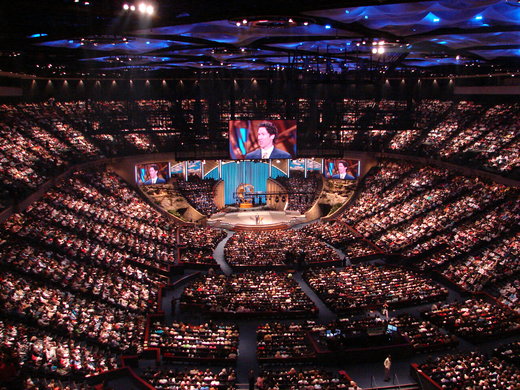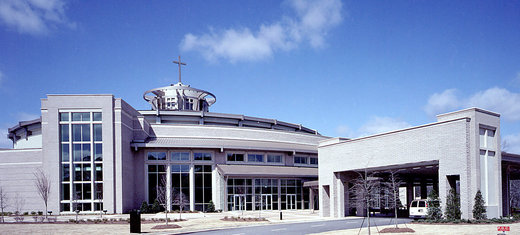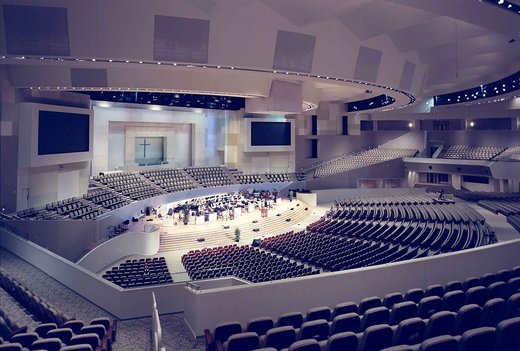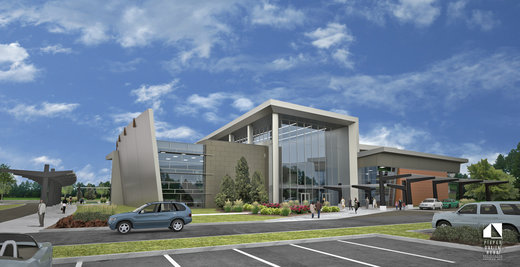By Chris Soffe in Atlanta

Imagine this: you walk into a theatre filled with 4,000 people, all singing, clapping, and in some cases even dancing.
Are you at a rock concert?
No, it’s Sunday morning in the US.
Nearly six million Americans worship each week at what have been dubbed “mega churches”.
These aren’t just your everyday church, or cathedral even – they host congregations ranging from 2,000 to 30,000, according to a recent survey.
We’ve seen a steady growth in the number of these churches across the US over the past five years.
In Georgia alone there are 91 on record, with the largest boasting an average attendance of nearly 31,000.

A service at Lakewood Church in Houston Texas (Credit: Paul Duron via Panoramio)
They’re an important source of work. As management and construction consultants, we’ve built longstanding relationships with several in the south-eastern states.
In 2002 we had our first chance to work with a mega church when we oversaw construction of the $55m First Baptist Church of Woodstock, just north of Atlanta.
Standing nearly 60 metres tall, with 38,000 sq m floor area, the complex included a 7,000-seat theater-style sanctuary, preschool space, music suite, classrooms, assembly areas, counseling rooms and more.
(I’m pleased to add that the project won the 2005 National Construction Management Association of America Project Achievement Award for Excellence in Program Management.)
We’re currently working on projects with four mega churches ranging in congregation size from 3,000 to more than 13,500.

Gleeds oversaw construction of the $55m First Baptist Church of Woodstock, just north of Atlanta. (Credit: Gleeds)
Offering more
Few types of organisations can boast the kind of growth mega churches enjoy in America right now, and it’s worth looking at why.
With their contemporary worship styles, they attract younger people – the average congregation age is 40, as opposed to the 53-year-old average of traditional churches.
They compete vigorously to attract new members through lively and engaging services, welcoming atmospheres and the reputation of their pastors for inspirational preaching and scholarship.
They work hard to make their message relevant to the pressures of American people today, and offer support for families, succor for singles, positive leisure activities, even career counseling and business networking opportunities.
And as congregations grow, church leaders look for more ways to serve their following, and this is where we come in.

First Baptist Church of Woodstock’s 7,000-seat theater-style sanctuary. (Credit: Gleeds)
That’s because for some, it means offering more worship services or growing their online ministry, allowing people from all over the world to tune in to sermons, outreach and worship.
But for the mega churches we work with, it means offering their congregations more, physically – more space, more seats, more things to do, more support and more ways to worship.
In our 10 years working with Word of Faith, just outside Atlanta, we’ve seen the church gain an 1,800-space parking lot, an 85,000 sq m sanctuary, plus an education building, fellowship hall, and daycare facility.

Word of Faith’s new facility will include a 600-seat theatre-style auditorium, fitness centre, food and retail space, and a bowling alley. (Credit: Pieper O’Brien Herr Architects)
We’re now helping with their EpiCenter project – a 10,500 sq m facility that includes a youth centre, 600-seat theatre-style auditorium, fitness centre, food and retail space, computer and career centre, six-lane bowling alley, and conference and banquet hall.
It’s no wonder mega churches are growing – they offer hope for the next world plus meaning and concrete assistance in this one.
Their growth is impervious to, and probably even fueled by, the tough economic conditions.
We don’t mean it at all cynically to say that for consultancies like ours, religion is a key business to be in.
Chris Soffe is president of Gleeds USA






